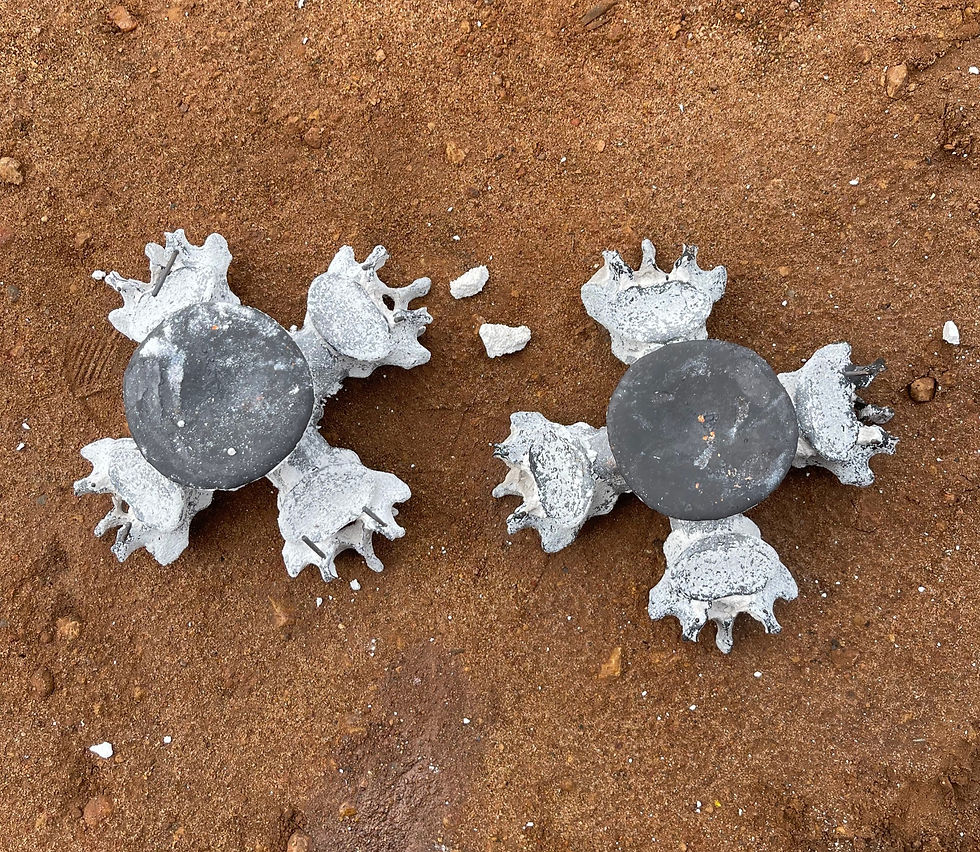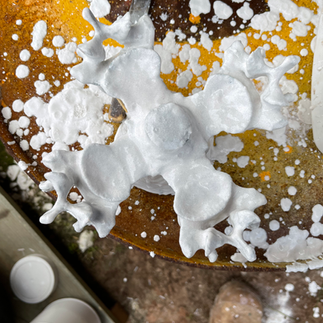Bronze castings can be unique personal gifts with special significance. One such project came to Dan Gentle Art Foundry recently, in the form of life-size human vertebrae to be cast in bronze.
The full casting process is described below.

The client who commissioned us for this project has endured serious spinal surgery a number of times in his lifetime, including a recent series of operations which kept him hospitalised for 5 days.
With a desire to show his gratitude to the medical teams who had looked after him, we were asked to cast seven exact copies of the lumbar vertebra "L5".
Below is a timeline of the Lost Wax Casting process used in this touching project.
1. Wax Recreation of Four Vertebrae, linked by a "Down Sprue/Feeder"
After taking a silicone mould of a vertebrae model, a wax reproduction was created. Every green wax part of the object below became bronze in the casting process. In this stage great attention is paid to the surface detail, as it is much easier to detail wax than it is to detail bronze. The central core - called the down sprue/feeder - was cut off after casting.
2. Investing Stage
Once the wax is fully detailed, it is ready to be "invested". This is where the wax is encased in a plaster material, which will be dried in a kiln to form a mould for the bronze to be cast into. During the kiln firing process, the investment is placed upside-down, to allow the wax to melt out, hence the term "Lost Wax" .
The investment must be added slowly at first, to allow even coverage and no slippages. It is usually flicked on by hand. Once a good coverage is achieved, the piece can be immersed in a bucket of plaster investment material, reinforced with wire. A weak investment would lead to a miscast (bronze leaking out of the mould). If this was to happen, the process would need to restart from the wax stage.
3. Post-Firing Stage
When the investments have been fired in the kiln, to the point where they are fully dry and the wax has melted away, they are removed from the kiln (whilst still hot) and placed into a supported "pit". Space around the moulds is filled with rammed sand, to add extra support.
"the timing of removing Lost Wax investments from the kiln and melting bronze to the point where it is ready to pour, is a careful dance that we undertake at Dan Gentle Art Foundry"
Bronze ingots are melting in a furnace nearby, to the temperature of 1180 degrees Celcius. The timing of removing Lost Wax investments from the kiln and melting bronze to the point where it is ready to pour, is a careful dance that we undertake at Dan Gentle Art Foundry. It is crucial that they are ready at the same time.
4. Fettling, Re-detailing and Finishing
We always have a moment of truth post-casting, when the investment is removed from the "pit" and smashed off. Until we see the bronze inside, we don't know whether there was a miscast. In this project, there were no miscasts, so it was just a matter of cutting off the central core (fettling), tidying up the sculptures' surfaces (re-detailing) and then finishing (in this case, applying a wax).

5. Finished Product



































Comments